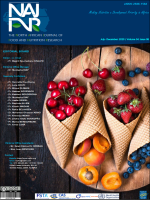Main Article Content
In vitro, antioxidant activities of aqueous and methanol roselle (Hibiscus sabdariffa) calyces extracts from two localities in Cameroon
Abstract
kground: Fighting against malnutrition and diseases such as oxidative stress diseases via a food-based approach could be achieved through identification, valorization, and promotion of local foods rich in macro- and micronutrients and phytochemical components. Aim:This study aimed to investigate the effect of agro-ecological conditions on the antioxidant capacity of the Hibiscus sabdariffa aqueous and methanol calyces extracts. Materialand methods:The total phenolic content, the free radical DPPH• (1,1-diphenyl-2-picrylhydrazyl), and ferric reducing antioxidant power (FRAP) activities were evaluated in aqueous and methanol Hibiscus sabdariffa calyces extract samples from two localities (Dschang [western highland zone] and Ngaoundéré [high Guinean savanna zone]) in Cameroon. Results: The results obtained showed that these extracts contain an important amount of total phenolic compounds with no significant difference (P>0.05) between aqueous and methanol extracts and also between the origins of calyces. The extracts showed their ability to reduce Fe3+ to Fe2+ as well as their ability to reduce the free radical, DPPH•. Concerning the FRAP results, at the concentration of 12.5μg/mL, the absorbance of AEN (Aqueous Extract from Ngaoundéré locality) recorded the value (0.33±0.05) meanwhile at a far higher concentration of 200 μg/mL, the absorbance of MEN (Methanol Extract from Ngaoundéré locality) was the highest (1.39±0.06). The CI50 of methanol extracts was significantly low (P<0.05) compared to that of aqueous extracts. The value ranges were 11.31±0.15, 14.69±0.84, 18.07±0.63, 20.50±0.54, and 21.50±0.54 μg/mL for ascorbic acid, MEN (Methanol Extract from Ngaoundéré locality), MED (Methanol Extract from Dschang locality), AEN (Aqueous Extract from Ngaoundéré locality), and AED (Aqueous Extract from Dschang locality) respectively. Conclusion:These findings show that the antioxidant activity of methanol extract is higher than that of aqueous extract. Hibiscus calyces from the two localities could be used as a natural antioxidant in the treatment of oxidative stress diseases.





